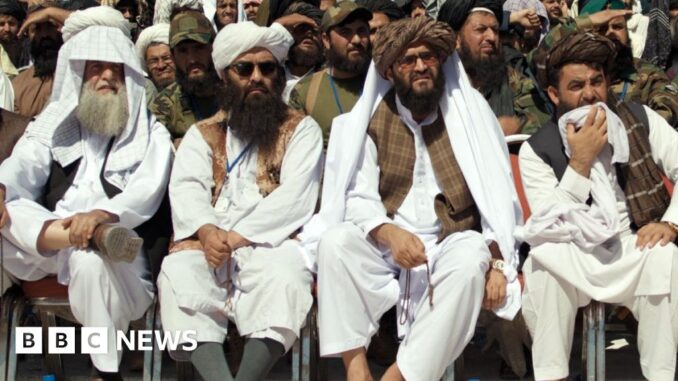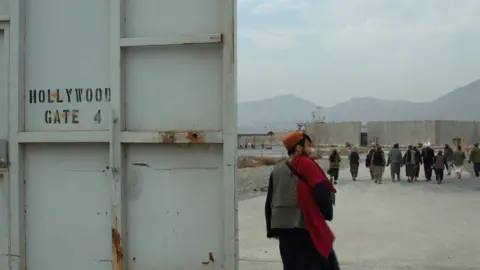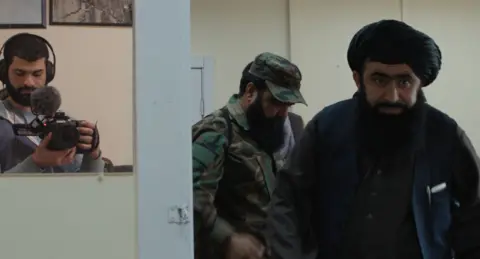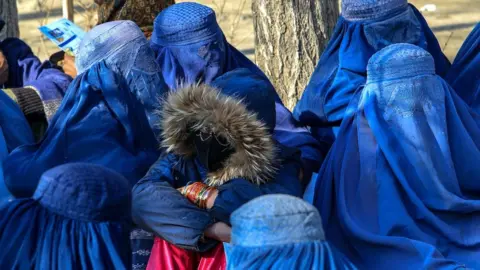
 Rolling Narratives
Rolling Narratives In August 2021, the world watched desperate scenes of multitudes fleeing Afghanistan as the Taliban swept into the capital, Kabul.
Having regrouped in the decades after being driven out by the invasion that followed the 11 September attacks, and emboldened by the agreed withdrawal of the remaining US forces, the Taliban deposed the elected government.
But while thousands left, some had been trying to get into the country – including Ibrahim Nash’at, an Egyptian journalist and film-maker based in Germany.
After much persistence, Nash’at succeeded in getting permission to stay in Afghanistan for up to a year to film primarily with the country’s then newly appointed Commander of the Air Force, Malawi Mansour, along with a young Talib lieutenant, MJ Mukhtar, who in the film dreams of joining the air force and longs to avenge himself against the Americans.
Now, three years on from the Taliban’s return to power, the result is the documentary Hollywoodgate, named after the abandoned CIA military base where much of the filming took place.
But in seeking to tell the tale of the country’s new era, Nash’at found himself in an uncomfortable and often fraught position with a new government that had become known for execution and repression during its first stint in power.
“That little devil is filming,” an unknown Taliban military figure comments to Mukhtar in Nash’at’s presence. “I hope he doesn’t bring us shame in front of China.”
On another occasion, Mansour says casually in front of Nash’at that “if his intentions are bad, he will die soon.”
Asked about it, Nash’at says: “I actually didn’t understand what they were saying at the time. I’d asked the translator not to tell me bad things they said about me. I didn’t want to freak out.”
 Rolling Narratives
Rolling Narratives Although frequently told to stop filming, he acquired more than enough footage for this fly-on-the-wall style story, where audiences see the vestiges of American troop life such as treadmills (Mansour asks in the film for one to be sent to his house), signs for unisex toilets and a fridge containing alcohol, but also some of the $7bn (£5.4bn) stockpile of weapons that the US confirmed later it had left behind, including around 73 aircraft and 100 military vehicles.
“These monsters spent their last days here destroying everything,” says one of them about the Americans, as Mansour and his team inspect the former CIA base for the first time by torchlight.
The US military command said at the time that military equipment had been rendered “impossible” to use again, although Nash’at films some aircraft repairs being carried out and the documentary features scenes where his officials assure Mansour that some are fixed and ready to be tested in the air.
Questions for the US
Nash’at tells BBC News he was “shocked” to discover all that had been left behind.
“When I first saw the word ‘Hollywoodgate’ on the base from the road, that was it for me,” he says.
“I thought I would make a movie about this crazy space that was American, and then it’s occupied by the Taliban Air Force. I thought it might be about how they sleep in American beds, but it’s become much more about the weapons.”
“It’s unbelievable these things even exist,” he continues. “It’s really a question for the American authorities, why did they leave all of this behind? How many more warehouses did they leave full? And right until the end of my filming, I never thought they [the Taliban] would be able to fix them.”
However, later scenes of the film, filmed one year later in August 2022, show a military parade at Bagram Air Base in front of the Afghan prime minister and minister of defence, with much of the US weaponry on triumphant display, as they host diplomatic visitors from countries including Russia, China, Pakistan and Iran. Mansour orders a flypast of several aircraft.
US media networks have since reported that weapons left behind in Afghanistan have surfaced in other conflicts around the world.
“The movie really shows the transformation of the Taliban from being a militia into a military regime,” the director claims.
 Rolling Narratives
Rolling Narratives Nash’at didn’t get to film anything after that parade, he says, because immediately afterwards the film-maker felt he had to flee, as he was told to report to intelligence officials and have his footage inspected. He went to Kabul airport instead.
“They said to me, ‘Hey, come to our office tomorrow with all your material, we want to check it,’” he recalls. “For me, this was a huge alert. So I left Afghanistan at once.”
“I know from these kinds of regimes the moment you go down that road, it’s going to be a downward spiral, it’s never going to be something good,” he says.
Nash’at explains that he went into the country as most others were trying to leave, “because as a journalist, I learned when something is no longer the hot story, no-one cares about it any more. I wanted to go in and do the opposite.”
What ultimately got him access, he adds, was that in during his career, he had “filmed with world leaders, and they [the Taliban] saw images of me with presidents”. And the film comes with a prestigious pedigree, as it is co-produced by Canadian Odessa Rae, also behind the Oscar-winning documentary Navalny.
Nash’at argues that “for me, the name Hollywoodgate is a representation of what this movie is about. It’s a film about the Taliban trying to show that they understand propaganda.
“It’s also about the Hollywood stories that we’ve been told about this kind of military world. It has so many layers for me, I feel that it’s a scandal sponsored by Hollywood itself. It functions like a Greek theatre where the failure of the US-led occupation of Afghanistan is played out.”
 Rex/Shutterstock
Rex/ShutterstockNash’at’s filming was restricted according to the orders of the Taliban commanders he filmed with. The New York Times review of the film calls it a “frustrating documentary” as a result.
“There is no question that the director… faced tremendous danger in shooting… but the risks required to make this documentary also highlight its limitations,” it says.
However, the Guardian’s review of the film points out: “If his finished film is light on probing interviews and rigorous analysis, there’s an obvious reason: his subjects all hate him.”
Ibrahim is philosophical about this. “I think with these kinds of situations, when you take such a risk, know that there’s risk involved, then you’ll live the rest of your life knowing that there’s a risk involved. And it’s something I’ve come to accept.”
He also emphasises that his voiceover at the start of the movie tells the audience that the Taliban wanted the audience to see some of the images he filmed.
“I ask the audience, despite that, ‘may I show you what I saw?’” he says. “My job as a filmmaker is to raise questions and hope the spectators will pick up these questions and try to find answers for them. My goal is that we can see through the ways they present themselves and understand the truth of their ambitions for control—of women, of their countrymen, of their larger geo-political region.”
Ordinary Afghans are usually portrayed in the film observed from a car or truck. There are no women in this film at all – just a couple filmed in passing.
One particularly poignant image is of a woman dressed in a burka, sitting in an icy road. Other women, shapes in burkas, sit outside a shop. It looks like, but it’s not clear, whether they are begging.
‘Painful to watch’
In the three years since the Taliban took control in Afghanistan restrictions on women’s lives have increased: girls have been excluded from secondary schools, prevented from sitting most university entrance exams and women restricted in the work they can do, with beauty salons being closed, as well as being stopped from going to parks, gyms and sport clubs. Mansour talks about how his wife was a doctor before their marriage, but that he made her give it up.
The UN estimates that more than two-thirds of the country does not have enough food, and that the situation has got worse because of the economic sanctions on women.
“It’s painful to watch these images and know this is the reality. It’s very ugly. What’s happening there, it’s just painful,” Nash’at says.
“When I left, I was haunted by the futility of the material I had, thinking I might not be able to convey the pain of the Afghan people.
“Even if I was with the Taliban, I can see in people’s eyes the fear they have, the sadness, the tiredness. The poverty levels are on a scale I’ve never seen in any other country, and I’ve travelled a lot. It’s really sad that this country is where it is today and that nobody really cares about what’s happening to it.”
“I did choose to go to Afghanistan. I did choose to make this from Afghanistan,” he admits.
“All of the suffering that I’ve gone through in making the film, this is nothing compared to the daily suffering of the Afghans.”
Hollywoodgate is in UK cinemas and available on Curzon Home Cinema now.



Be the first to comment